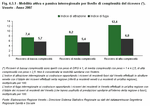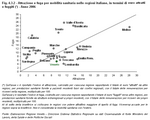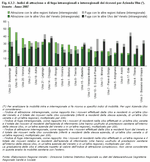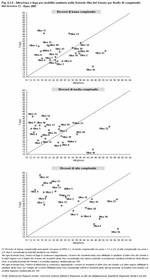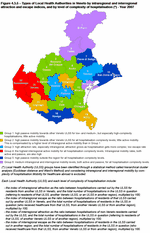4.3 - Mobility for healthcare
|
Since the end of the 1970s people have had the freedom to choose their doctor and the establishment in which to receive healthcare under Law no. 833/78 (Note 1). It was not until the 1990s, however, with the revision of health laws under Legislative Decrees D.L. no. 502/92 and no. 517/93 that people also gained complete freedom in the choice of place to go for their healthcare. Up until then, authorisation was required if a person wanted to receive healthcare in a different region to his or her place of residence (Note 2).
From here on, mobility for healthcare, or the tendency for people to use the health services in another region (or of another health authority) began to be quite an issue. Furthermore, following changes to Title V of the Constitution, the health system was recently regionalised, which gave regional health services major autonomy in planning and administration and paved the way for a real competitive market in the provision of healthcare. It is also true to say that although the Italian health system guarantees everyone the choice of where to receive healthcare, good regional health policies should be able to meet the health needs of all that region's own residents and thus discourage people from looking for care outside of the region. There are many reasons a person would choose to look beyond the borders of their own region for their healthcare needs: they may actually be closer geographically to establishments in another region; they may be living somewhere different temporarily for study or work (in both cases this is 'fake' mobility); or they may need specialist treatment which is only available in certain hospitals (mobility for physiological reasons). For planning purposes and in order to improve services it is more important, however, to focus on those movements that could be avoided, i.e. those motivated by the search for better quality healthcare or by a lack of suitable establishments within the person's own region. Faith in a certain establishment and its reputation also cause people to move around, as do certain managerial and bureaucratic issues, such as the length of waiting lists. Analysing mobility for healthcare, if it is seen as mobility that could be avoided, enables us to examine certain establishments' abilities to satisfy patient needs and to find out if people's opinion of the health services available to them is well-founded. A patient who chooses an establishment in a different region to their own implicitly indicates that in their opinion the establishment closer to home is of a lower quality. An analysis of mobility based on the type of service provided by an establishment enables us to assay where healthcare is lacking both in terms of quality and quantity. The phenomenon of mobility for healthcare also has economic implications, as a citizen who receives healthcare in a hospital far from their home brings about a negative effect on their local authority's or region's balance sheet (Note 3). In short, mobility for healthcare plays a central role nowadays in planning regional systems and in developing common regional policies. To this end, in their meeting on 4 December 2003, the Conference of the Presidents of the Regional Parliaments and of the Autonomous Provinces approved the "Protocol for interregional agreements on the management of mobility for healthcare in bordering areas". This protocol laid out general principles and criteria based on which border regions can create formal agreements to regulate mobility for healthcare and encourage a more rational use of establishments and a more efficient employment of resources. Regione Veneto and Regione Emilia Romagna undersigned a framework agreement, which is acknowledged under Regional Decision D.R. no. 2908 of 18 September 2007, and valid from 1 October 2007 until 31 December 2009. The stipulation of a framework agreement with Regione Friuli Venezia Giulia is also underway. In this report we will take into account active and passive mobility, and hospital cases only, even though these do not encompass all of the movements for healthcare reasons. In terms of active mobility we will evaluate the services offered to residents of other regions by Veneto's regional health system, and for passive mobility, the services received in other regions by Veneto residents.
There were almost 864,000 hospitalisations in Veneto hospitals in 2007; this is a 4.2% drop on 2006. In around 70% of cases, stays in hospital lasted more than one day, the remainder were out-patient visits for day-care.
A total of 8.9% of the hospitalisations concerned non-Veneto residents, of these 88.8% of cases concerned patients from other Italian regions and the remainder were foreign citizens. Veneto mostly attracts patients from bordering regions (Note 4): Lombardia takes the lead (22.2% of non-Veneto patients are from this region), followed by Emilia Romagna (14.8%), Friuli Venezia Giulia (14.4%) and Trentino Alto Adige (13.6%). Despite the distance, Veneto also attracts many patients from southern regions, for example Sicilia which made up 8.6% of hospitalisations of non-Veneto residents. As for hospitalisations of patients resident in Veneto, 6% occur in establishments not in Veneto (47,280 hospitalisations in total); these are mainly in bordering regions such as Friuli Venezia Giulia, Emilia Romagna and Lombardia. The largest share of patients from other regions comes for specialised surgery: neurosurgery in particular (29.4% of patients discharged from this ward in 2006 were from outside the region); heart surgery (16.1%); and ophthalmology and urology. Instead, Veneto residents go to other regions mainly for rehabilitation, infectious diseases and heart surgery (Note 5). Analysing movements to a hospital in another region in terms of the complexity of procedures carried out (Note 6) enables us to look at mobility for healthcare in greater depth. If a person goes to another region to treat a low-complexity illness, then we can assume that there is low confidence in local services and perceived quality of care (Note 7). Differences in mobility for healthcare according to the complexity of the hospitalisation can often be attributed to avoidable mobility, which points towards the patient's own personal preference. If mobility were only for physiological reasons, results would vary very little for all levels of complexity. (Figure 4.3.1) For Veneto, the escape index (Note 8) varies greatly depending on the level of complexity of the procedure: around 6%-7% of every 100 Veneto residents hospitalised choose a hospital outside of the region. Vice-versa, the attraction index varies much more dramatically as the complexity of the procedure increases, from a 7.4% attraction index (Note 9) for low-complexity procedures to 12.4% for those with a much higher specialisation. In order to compare the regions, attention must be given to the financial-impact mobility that mobility for healthcare can have on regional balance sheets: patients escaping to other regions and being attracted from other regions are not considered in terms of the number of hospitalisations, but in terms of the cost of each procedure (Note 10). If we look at the financial difference between procedures carried out on patients from outside Veneto ("brought in" euro) and those on patients leaving Veneto ("escaped" euro) for 2006, according to Ministry of Labour, Health and Social Policies data, Lombardia boasts the most positive balance with almost 315 million euro. Emilia Romagna is next on the list with 172 million euro, and Veneto is in third place with 78 million euro. At the bottom of the ranking are many southern regions with a negative balance; Campania for example has a negative balance of almost 200 million euro. Veneto's expenditure on hospital care for its residents reaches almost 1.7 billion euro; of this reimbursements to other regions for healthcare provided for Veneto residents makes up almost 5.4% (escape index in monetary terms) (Note 11), one of the lowest figures out of all of Italy's regions. Revenue from other regions for hospital care provided by Veneto for their residents makes up 9.3% of total Veneto hospital expenditure (attraction index in monetary terms) (Note 12). In the graph, the lower down a region is, the more it manages to satisfy local demand and reduce numbers of residents leaving for other regions, thus leading to lower expenditure on reimbursing other regions. The more towards the right it is, the more patients it attracts and so the more income it gains from other regions. When income from active mobility equals expenditure on passive mobility then the region is located on the bisector. As Italy's health system bases itself on equal access to services, the ideal situation would be if every region managed to cater for its own community's health requirements, therefore reducing both active and passive mobility for all regions (a region in this situation would be located in the lower, left-hand section of the graph). Many of the northern regions had the best results in terms of attractiveness, while the regions in the South had the lowest values, Sicilia and Sardegna in particular as they are penalised by their separation from the rest of the country. Veneto stands in a good position below the bisector as numbers escaping are fairly low and numbers attracted are higher than those leaving. According to a survey by the Picker Institute, a British organisation, 87% of patients hospitalised in Veneto deemed the healthcare they received to be excellent, very good or good, and only 2% thought it bad. This good overall verdict is mainly due to confidence in the professional ability of health service employees; there are still a few problems, however, mainly regarding social and emotional support and relationships and communication with the patient's family. (Figure 4.3.2)
In terms of the work carried out by each Local Health Authority (ULSS), mobility between hospitals can be separated even further into intraregional mobility, i.e. mobility between different local health authorities within one region, and interregional mobility, i.e. mobility between the health authority and other regions (Note 13).
Interregional mobility mainly regards the Local Health Authorities situated on the borders and those including hospital corporations. The ULSS of Bussolengo, Padova and Verona in particular attract more patients for more complex procedures. Patients tend to leave the Local Health Authorities of Pieve di Soligo, and San Donà in particular, for other regions, and not necessarily only for high-complexity hospital procedures. Rovigo, on the other hand, balances out the number of patients escaping with the number of patients arriving. (Figure 4.3.3) In terms of intraregional mobility, the Local Health Authorities differ widely. This can also be attributed to agreements between authorities, especially if they border one another, and also to regional organisation of services, which aims to make the local health system more efficient. The smallest Local Health Authorities tend to be most affected by intraregional passive mobility as their residents go to bigger health authorities, to the provincial health authorities, or to those including hospital corporations for their healthcare. For example, residents under the ULSS of Thiene and Arzignano often choose to go to the Vicenza Health Authority, while those from Asolo and Pieve di Soligo go to Treviso. Patients leave their Local Health Authority for low-to-medium specialised procedures (escape index of around 30%), but mainly for high-complexity procedures (index of around 45%). This is particularly evident in the smaller ULSS in the province of Vicenza and in those of Chioggia, Este and Mirano. The Local Health Authorities of Padova, Treviso and Vicenza stand out for attracting patients both from within the region and from other regions, and for the fact very few local patients go elsewhere, as these Health Authorities are even able to cater for highly specialised cases. (Figure 4.3.4) If we look at both intra- and interregional mobility overall, differences emerge between Local Health Authorities as complexity of hospitalisations increases. Some Local Health Authorities, such as Vicenza, Padova, Verona, Treviso and Bussolengo, attract patients for procedures of low, medium and high complexity; in the graph these ULSS are located below the bisector line. Local Health Authorities that contain hospital corporations shine in terms of procedures for high levels of complexity. Above the bisector are those ULSS where passive mobility prevails for high-complexity procedures. For some of them mobility is passive whatever the complexity of the procedure. Others are able to compensate for patients leaving through the low- and medium-level specialisations, but for highly complex procedures escape levels continue to increase; examples of this type are the ULSS 14 of Chioggia and the ULSS 4 of Thiene. (Figure 4.3.5) |
|
Data processed by the Statistics Office of Regione Veneto are collective property; reproduction of this material is authorised for non-commercial purposes only, provided the source "Regione Veneto - Regional Statistics System Management" is acknowledged.
English translation by the University of Padova Language Centre.




